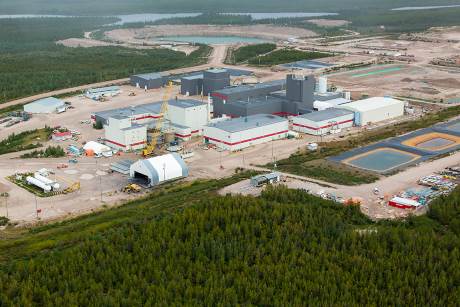Areva Resources Canada and researchers at the University of Saskatchewan have completed a major study on the long-term condition of uranium mill tailings at the McClean Lake mill using the Canadian Light Source (CLS) synchrotron facility.
 |
| McClean Lake (Image: University of Saskatchewan) |
Tailings - the waste from uranium ore milling operations - from McClean Lake are stored in the JEB tailings management facility, a former open pit mine. The management facility has been in operation since 1999, so drilling through the layers of material in the facility gives a snapshot of the tailings at different evolutionary stages.
Researchers used the CLS to investigate the life cycles of elements such as lead, arsenic, and molybdenum via X-ray Absorption Near-Edge Spectroscopy (XANES), a technique that can detect specific elements at very low concentrations. University of Saskatchewan lead researcher Andrew Grosvenor explained the approach. "We want to know how the materials that contain these elements of concern are changing over time, and if they reach a point where they form an insoluble product in which case everything would stay put," he said.
The study has involved analysing 25 samples of tailings of different ages and has for the first time succeeded in confirming the formation of solid molybdenum materials that eventually stop the element dissolving into water, as previously predicted by thermodynamic modelling.
McClean Lake is operated and 70%-owned by Areva Resources, with Denison Mines holding 22.5% and Overseas Uranium Resources Development (OURD) of Japan owning 7.5%. The mill produced over 50 million pounds of concentrate from three open-pit mines from 1999 to 2010, and has since been upgraded to mill ore from Cameco's Cigar Lake mine. It has been described as the most technologically advanced uranium mill in the world, able to process ore grades from less than 1% to 30% uranium without dilution.
Based on current mining and milling projections, approximately 5 million cubic metres of tailings will be generated at the McClean Lake Operation over the next 25 years, and will be stored in the JEB facility.
The study's findings will be invaluable to the long-term care of the McClean Lake site, and researchers are looking to move on to other elements of concern. "Once you understand the geochemical reactions that are occurring then you can start to predict what will be occurring over the next 50, 100 or 1000 years in the environment," Grosvenor said.
The research has been published in the journal Environmental Science & Technology.
Researched and written
by World Nuclear News





_63865.jpg)
_18570.jpg)
_16159.jpg)





